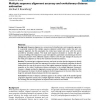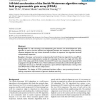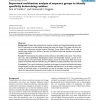40 search results - page 4 / 8 » Inferring Positional Homologs with Common Intervals of Seque... |
BMCBI
2005
13 years 7 months ago
2005
Background: Sequence alignment is a common tool in bioinformatics and comparative genomics. It is generally assumed that multiple sequence alignment yields better results than pai...
BMCBI
2007
13 years 8 months ago
2007
Background: To infer homology and subsequently gene function, the Smith-Waterman (SW) algorithm is used to find the optimal local alignment between two sequences. When searching s...
BMCBI
2011
12 years 11 months ago
2011
Background: Using microarray and sequencing platforms, a large number of copy number variations (CNVs) have been identified in humans. In practice, because our human genome is a d...
BMCBI
2007
13 years 8 months ago
2007
Background: Proteins that evolve from a common ancestor can change functionality over time, and it is important to be able identify residues that cause this change. In this paper ...
BMCBI
2006
13 years 8 months ago
2006
Background: Multiple sequence alignment is the foundation of many important applications in bioinformatics that aim at detecting functionally important regions, predicting protein...



